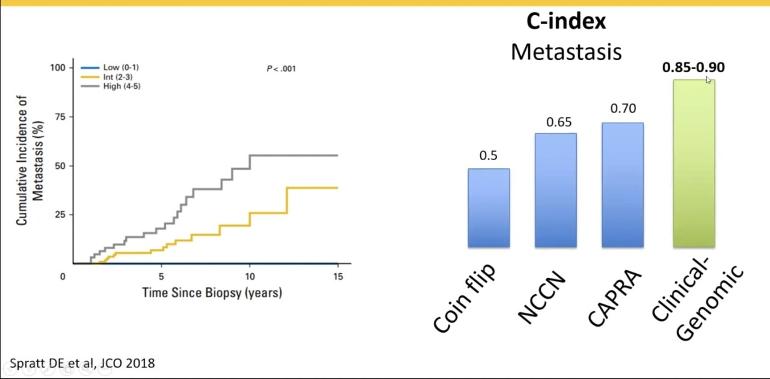Decipher genomic testing can help determine who will not benefit from ADT treatment thereby sparing them from side effects. When combined with SOC testing it increase predictive accuracy for who will have metastisis (MET) by 85-90%. Both biopsy and clinical specimens can be used. I had my Decipher done with my clinical specimen post RP; it was a whopping 0.97 out of 1.0 for risk; it should have come back 0.5 to match my Gleason of 4-3! The Decipher results helped me decide on sRT (salvage radiation) immediately and 2 years of ADT follow up. If nothing else its a good biomarker for your PCa and will help you further refine the visual GS gleason grade you received. I look at GS as the direction your PCa will take and a genomic test as the speed it will travel by.
Highlights: at each minute mark.
Min 2:50; OS Overall survival PCa
-35% died from prostate cancer in 18 years
-30% had no disease
-all high-risk cancer patients
-need for better stratification and risk prediction
Min 3:23; risk stratification
current tools are all used
PSA, Gleason score, T stage, CAPRA and Star CAP
25 to 45% error predictive value
Min 7:10; prognostic indicator.
-decipher is an independent prognostic indicator with high accuracy
Min 7:48; SOC + Biomarkers
-combining provides substantial improvement in prediction
Min 14:40; biomarker test comparison
-top three tests compared
-Decipher is the most robust
-It provides the most evidence
Min 17:25; use of grid signatures
-gene grid report is provided by decipher
-pulls in other genes
-15 to 20 additional included
-Polaris genes are provided
-Doctors should look for concordance between the grid and the decipher prediction
-Grid provides androgen response prediction and will identify patients who will benefit most from ADT
Min 19:03; Best predictive value for test
-determining if the use of hormone treatment will be effective
- sparing men the adverse impacts of ADT when it will not provide additional survival benefit
